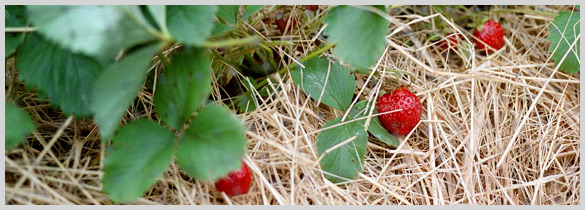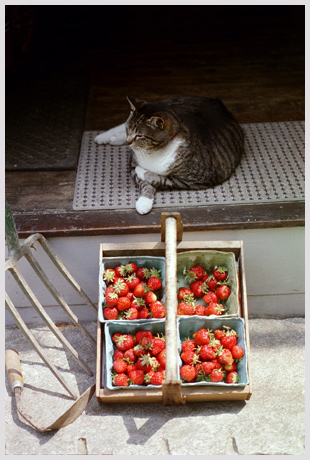Fresh Strawberries: An Independence Day Tradition
An Independence Day Tradition
By Lynette L. Walther
 For best results, establish new strawberry beds in spring, using purchased plants or runners from established beds.
For best results, establish new strawberry beds in spring, using purchased plants or runners from established beds.
Strawberry beds should be re-planted every two years as plants wear out. Photo: Lynette L. Walther
Come the Fourth of July, any self-respecting Maine gardener wants to contribute two important items to the holiday menu: first-of-the-season green peas and ripe red strawberries. No Independence Day celebration would be complete without them.
Indeed, one whole corner of our vegetable garden is devoted to strawberries. The location rotates around the garden patch as we establish a new bed every other year. As the old plants get worn out, a new batch is always coming along so we can be assured of ripe and sweet strawberries every summer.
Each spring, new “runner plants” spread out from the mother plants. As a rule of thumb, it is best to space these little plants about six inches from the mother plants, as well as six inches from each other. This usually results in a row that is about 18 inches wide.
Extra runners should be removed so they don’t crowd the fruiting row. They can be added to the compost pile or used to establish a new bed for next year’s harvest. Plant new beds this time of year for best results. That way they have the summer to get established. That time helps them to survive the winter and then hit the ground running the following spring for a bountiful crop in time for the Fourth of July.
 A big flag and a bowl of strawberries fresh from the garden
A big flag and a bowl of strawberries fresh from the garden
make for a Maine-sytle Fourth of July.
Photo: Lynette L. WaltherHere’s how to establish a new strawberry bed from runner plants or new plants:
• First prepare the new bed by removing all weeds. Cultivate to loosen the soil. Add well-rotted manure or compost at this time. If the soil is heavy and easily compacted, mix in some clean sand for good drainage -- essential for successful strawberry culture. Strawberries need good drainage as much as they need regular moisture.
• Using a hoe, form slightly mounded rows that are spaced about three feet apart. This will help ensure that plants never end up sitting in standing water. Continued wetness could promote disease and rot.
• Next, apply a thick layer of straw over and between the rows. No, we haven’t forgotten to plant the strawberries! Mulching the bed is much easier to do before the little plants are in place. The mulch serves a number of purposes. It keeps weeds down, helps keep the soil cool and holds in moisture. But the most important reason to mulch strawberries is because it keeps the berries off the ground. This keeps them cleaner, and helps to prevent mold or diseases that they can pick up from the soil.
• Moving down the row, spread a hole in the straw mulch, and plant the strawberries using what could be called the “Goldilocks” method: Not too deep, not too shallow, but just right. This means placing the crown of the plant at soil level, with the roots placed straight down. Planted too deeply, strawberries are subject to crown rot, too shallowly and they can dry out. Replace the mulch around the plants as you snug them into the ground.
• Now for the hard part. Remove all blossoms on the new plants so that their energy will go into producing strong plants, rather than a few puny berries. This will have to be done several times over the course of the season to be sure that all blooms are removed. The reward for this diligence will come next summer.
• Keep the plants watered throughout the spring and summer. Adequate moisture, at least an inch a week, is more important than fertilizer. This is true for both new and established beds. Strawberries are shallow-rooted plants.
• In the late fall add to or replace the straw to provide a thick layer for winter protection. This is a good time to work in some rotted manure between the rows.
• Now you are all set to enjoy your own home-grown berries — next summer.
It is estimated that a 100-foot row of about 100 plants will produce 30 to 50 quarts of berries.
 The payoff — There’s nothing like sweet, juicy strawberries
The payoff — There’s nothing like sweet, juicy strawberries
from the garden for a star-spangled Fourth of July.
Spike (the cat )supervises garden activities and harvests.
Photo: Lynette L. WaltherBecause we tend to be a bit selfish when it comes to sharing our strawberries with the birds and chipmunks we’ve employed a number of strategies to keep critters out of the patch. Some have been successful, though not completely. Those ripening berries are a real temptation.
Our garden is surrounded with three lines of an electric fence. That keeps out the big thieves. A fine mesh can be placed over the plants to keep birds out. This worked well for several seasons, until we accidentally trapped a catbird under the mesh — not a good thing. Next we tried stringing up plastic CDs with almost-invisible monofilament line.
The disks twirled in the breeze, and sent out a rainbow of flashing rays that worked fairly well to scare the birds away, but not the chipmunks. The best defense we have found against them is to grow plenty of berries, and pick the fruit often before the “chippies” can get to it.
There are many varieties of strawberry plants that are grown in many conditions from the deep South to Canada. Buy plants from local sources rather than from mail order houses to be sure that you are getting varieties that grow and produce well here.
Yes, they are a bit of work, and bit of worry, but the payoff is indeed a sweet one. You’ll be happy you did it, come Independence Day.

 For best results, establish new strawberry beds in spring, using purchased plants or runners from established beds.
For best results, establish new strawberry beds in spring, using purchased plants or runners from established beds. Strawberry beds should be re-planted every two years as plants wear out. Photo: Lynette L. Walther
 A big flag and a bowl of strawberries fresh from the garden
A big flag and a bowl of strawberries fresh from the garden make for a Maine-sytle Fourth of July.
Photo: Lynette L. Walther
 The payoff — There’s nothing like sweet, juicy strawberries
The payoff — There’s nothing like sweet, juicy strawberries from the garden for a star-spangled Fourth of July.
Spike (the cat )supervises garden activities and harvests.
Photo: Lynette L. Walther

Contributing Garden Editor Lynette L. Walther is the recipient of the National Garden Bureau’s Exemplary Journalism Award and the IABC Silver Quill Award of Excellence. She is a member of the Garden Writers Association. She gardens in Camden.
Related Articles
Share this article:
2023 Maine Boat & Home Show

Join Us for the Maine Boat & Home Show!
Art, Artisans, Food, Fun & Boats, Boats, Boats
August 11 - 13, 2023 | On the waterfront, Rockland, Maine
Click here to pre-order your tickets.
Show is produced by Maine Boats, Homes & Harbors magazine.















